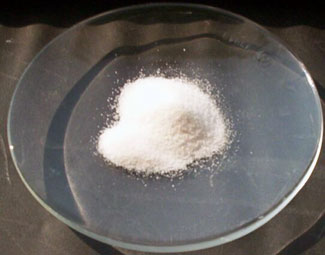Arsenic added to cancer therapy after studies in China
September / October 2015 | Volume 14, Issue 5

Photo by Martin Walker via Wikimedia
Scientists in China discovered that the compound arsenic trioxide,
pictured above, worked as a treatment for people with acute
promyelocytic leukemia.
by Shana Potash
When some people hear the word "arsenic," they immediately think of poison. But the chemical also helps save the lives of people with a rare type of leukemia. Chinese scientists were first to identify arsenic as a treatment for acute promyelocytic leukemia (APL).
APL, which can cause life-threatening bleeding, used to be one of the most fatal forms of acute myeloid leukemia. Now, it's one of the most treatable types in adults, with about an 80 percent cure rate.
"The treatment of acute promyelocytic leukemia is a success story of modern hematology," noted Drs. Eytan Stein and Martin Tallman, of New York's Memorial Sloan Kettering, in an article published in the journal Oncology.
Arsenic has been known as a poison and medicine for more than 2,000 years. In the 1970s, scientists in China discovered that the compound arsenic trioxide worked for people with APL, including those whose leukemia returned after standard therapy. Clinical trials in the U.S. confirmed the findings and the FDA approved the treatment in 2000.
When it comes to APL, arsenic trioxide is "definitely not a poison; the data suggest that it is more of a magic potion," wrote Dr. Bayard Powell, in an article in Expert Review of Anticancer Therapy. Powell, of North Carolina's Wake Forest University, led some of the NIH-funded arsenic trioxide studies.
Before arsenic trioxide, there was another medical advance in the treatment of APL. In 1995, the FDA approved a drug that comes from vitamin A, all-trans retinoic acid (ATRA), based on clinical trials in the U.S., China and France.
Researchers say, together, ATRA and arsenic trioxide have transformed the APL treatment landscape.
More Information
- Acute promyelocytic leukemia: where did we start, where are we now, and the future
Blood Cancer Journal, April 2015 (published online April 17, 2015)
- Provocative pearls in diagnosing and treating acute promyelocytic leukemia
Oncology, July 2012
- Arsenic trioxide in acute promyelocytic leukemia: potion not poison
Expert Review Anticancer Therapy, September 2011
- Chinese Folk Treatment Reveals Power of Arsenic to Treat Cancer, New Studies Under Way
Journal of the National Cancer Institute, May 2, 2007
- Supplement: Arsenic Trioxide
The Oncologist - Supplement 2, April 2001
To view Adobe PDF files,
download current, free accessible plug-ins from Adobe's website.